(Who owns the history? Power, art and democracy)
Per Christian Brown, Sidsel Christensen, Line Anda Dalmar, John Øivind Eggesbø, Jørund Aase Falkenberg, Tove Kommedal, Arne Nøst, Odd Sama
Curators Geir Haraldseth and Marie Stokkenes Johansen
Stavanger Kunstmuseum, Stavanger Museum, Stavanger Maritime Museum, Breidablikk, Stavanger
6.3.14
Art safari in the museums of Stavanger
On one evening only, the crowds of visitors joined a safari from museum to museum experiencing contemporary art. Eight local artists have been investigating the museums and their relations to power, art and democracy, in the light of the 200-year anniversary of the Norwegian Constitution. The art museum would be an obvious spot to display contemporary art, but what about the history museum, or the maritime museum, or the majestic villa Breidablikk?
* STAVANGER KUNSTMUSEUM *

John Øivind Eggesbø & Christopher Jonassen: Våre representanter
(Our representatives)
This was the by far most dominating contribution at the art museum. A giant cluster of artworks by local artists, contributed by those responding to the invitation by the initiating artist. The visitors are invited to vote on which artwork the museum shall buy for their collection. This seems like a very democratic approach. But thinking more closely about this, there are problems to it. Most of all, should the majority decide the contents of the museum's collection, what should be a representative collection of the art history? And are we sure that all local artists worth considering are present? Maybe some crucial artist or artwork is missing, and why is that?
This is in contrast to another of the current exhibitions at the art museum, about Ole Nesvik. A group of private persons collected money for a painting of a beach motive as a gift for the museum, but it refused to recieve it.
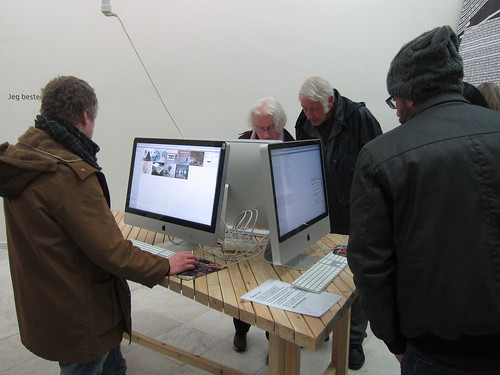
John Øivind Eggesbø: Våre representanter
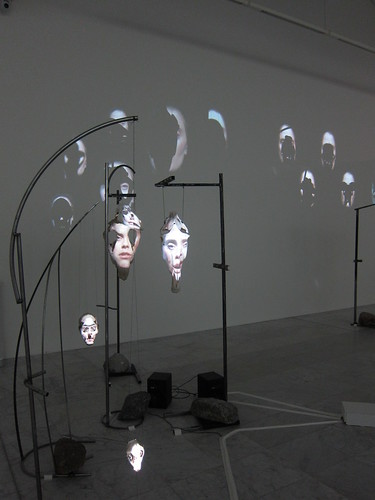
Arne Nøst: Historiens kakofoni (Vi spiser hverandre, og synger sanger)
It took me a while to discover that there were actually other artworks in this hall. This wonderful installation by Arne Nøst is worth the attention. It consists of video projections onto skulls found in the museum's collections. The projections on the skulls, their halo on the wall behind it, and the sound are of an actor singing the names of Homo Sapiens and twelve other mammals in Latin.

Line Anda Dalmar: Guide
On the floor in one of the halls are numbers and QR codes. They lead to descriptions of objects from Stavanger Museum, where the artist has invited a clairvoyant to describe her impressions of the objects.
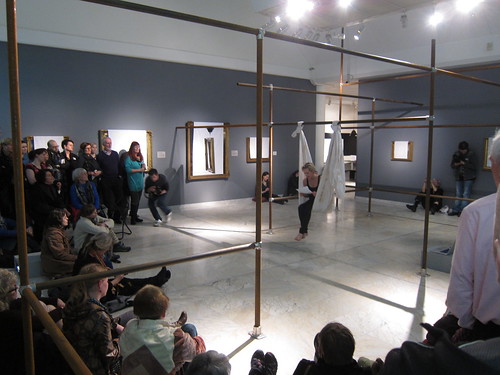
Sidsel Christensen: Christiane Schreiber utenfor rammen - 4 synsvinkler og 1 personlig brev
In this performance the artist climbs in her installation of iron tubes, while turning mirrors are reflecting her and the public, as the artist speaks about Christiane Schreiber, a female artist from the 1800s.
* BREIDABLIKK *
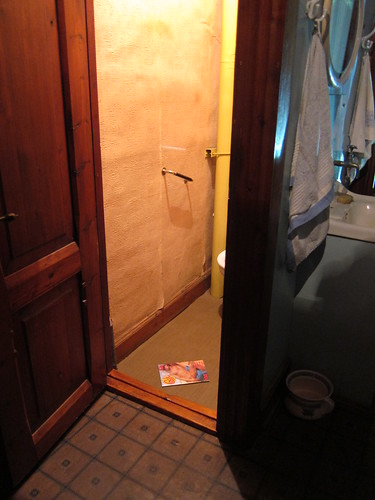
Per Christian Brown: Historistiske intervensjoner i villaen Breidablikk
In a house museum stuffed with the objects from the former inhabitants, the artist plays hide-and-seek with us. Some of his works are well hidden, other more obvious, and some dominate totally. There is a homoerotic magazine on the toilet, a mask put on one of the busts, and some of the paintings are replaced with a photo of the nearby park. Some rooms have video screenings: A set table with Cheese Doodles is juxtapozed with coverage of the annual food festival in town. In the sleeping room a drunk woman wanders around. And one room is fully occupied by birds.
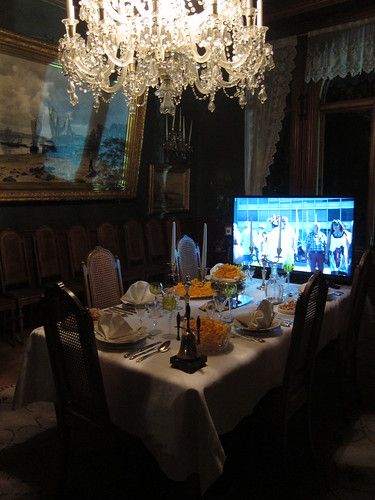
Per Christian Brown: Historistiske intervensjoner i villaen Breidablikk
* STAVANGER MUSEUM *
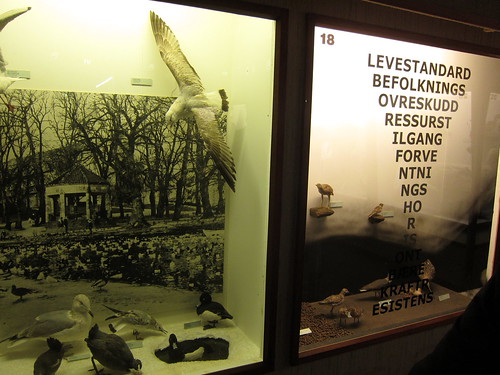
Odd Sama: Skriften på veggen
In the bird section of the museum, Odd Sama has added text to the original descriptions, pointing to ecological crisis, consumption, environmental issues.
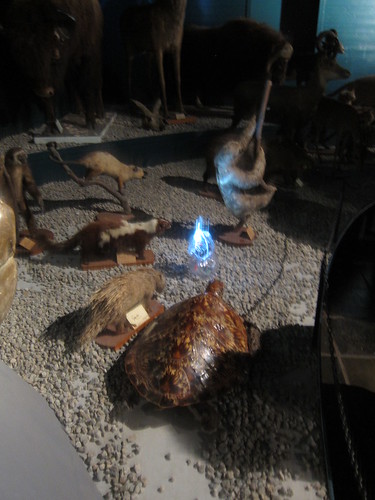
Jørund Aase Falkenberg: Utenfor sirkelen
Jørund Aase Falkenberg asks if animals should be treated as humans, thus all domestication of animals for human use should end. In a photo series stuffed birds are put to rest in a grave. And in the basement section for the weird collection, he has put glowing crystals, adding souls to the poor animals there.
* STAVANGER MARITIME MUSEUM *
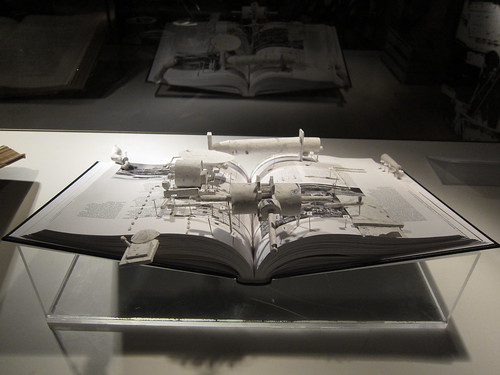
Tove Kommedal: Ekho
Hans Sundt Berggraf invented the echo sonar, but never got the full credit for it. He has been neglected in the Stavanger history, even if his invention has been crucial to both the fishing boom and the oil boom in the region. To restore his memory, Kommedal has added a display case to the museum's collection, and added the story to the four-volume History of Stavanger. In doing so she has added the original drawing found from an old technical magazine, and created the machine in paper made from unimportant part of the history volume concerning industrial history. In addition we hear the sound from a sonar, also remembering us of the Greek myth of Ekho, calling for her love Narcissus in vain, all response she got was her own voice.
This is not only a fascinating story, and it is interesting in why this is left out of the official history, but the sculpture itself, and the idea of making it, is just wonderful. This should be bought as a permanent installation in the museum.
*
I think it is a great idea to revitalise the museums in this way. In fact, this is the first time I visit some of these museums. In the game of finding the contemporary art, I am also lured into the museums, to enjoy the permanent exhibitions there. And I will probably return to them. In other words this is a win-win for both the museums and the local contemporary art scene.
But unfortunately the concept is stuck in a historical way of thinking: The Internet has been around for quite some time already, and should be used more in this project. The information about this project is limited on the web, and none of the documentation videos or the web based information by Line Anda Dalmar are accessible on the web.
But unfortunately the concept is stuck in a historical way of thinking: The Internet has been around for quite some time already, and should be used more in this project. The information about this project is limited on the web, and none of the documentation videos or the web based information by Line Anda Dalmar are accessible on the web.